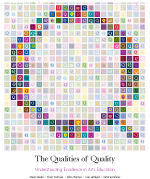The Qualities of Quality: Understanding Excellence in Arts Education

The Qualities of Quality: Understanding Excellence in Arts Education; By Steve Seidel, Shari Tishman, Ellen Winner, Lois Hetland, Patricia Palmer. Project Zero, Harvard Graduate School of Education (Cambridge, MA), 2009, 121 pages. Commissioned by The Wallace Foundation with additional support from the Arts Education Partnership
Funders need to pay attention to The Qualities of Quality, a brief and highly readable report commissioned by The Wallace Foundation with additional support from the Arts Education Partnership, and published by Harvard Graduate School of Education’s Project Zero. If funders intend to fund “the best” as a model for other grantees, they can check to determine whether their notions of best practices jibe with what the researchers found. If funders intend to help ratchet up the quality of arts education as taught in schools or communities, the report will help them isolate strengths and weaknesses so that they can be addressed with strategic financial support. If their mission is to help redress educational wrongs of the past or present, they can take warning from this report’s calls for cohesive and enlightened leadership and collaboration.
Steve Seidel, former codirector of Harvard Project Zero (HPZ), and his colleagues, Shari Tishman, Ellen Winner, Lois Hetland and Patricia Palmer, offer us a deceptively slim but deeply considered volume that explores three questions about both the arts and education:
- How do arts educators in the United States conceive of and define high quality arts learning and teaching?
- What markers of excellence do educators and administrators look for in the actual activities of art learning and teaching as they unfold in the classroom?
- How does a program’s foundational decisions, as well as its ongoing day-to-day practices, affect the pursuit and achievement of quality?
Through conversations with experts in the field; a literature review about quality as it intersects pedagogy, curriculum, and assessment; and site visits to twelve notable programs, the authors have blended theory and reportage to illuminate the issues related to a consideration of quality.
As with much about arts education in schools and community venues, the more one pokes around the issues, the more one sees that determining quality is a daunting task, especially for those who are less knowledgeable about how the whole teaching process works. Judgments must be made, however. So the essential question becomes, how can this book help us as funders and supporters of what we think are best practices?
Whether analyzing what goes on “in the [arts] room” or in the offices of micro and macro policy makers, the authors offer some sage advice regarding the pursuit and attainment of quality arts education in American schools.
In the first place, the Qualities study helps the reader to understand arts education practices in context by identifying the many influences on what arts teachers (credentialed or not) do and how they do it. By understanding the constraints and supports that can influence quality, the observer can make a more thoughtful hypothesis regarding the quality of a program and those who represent it in the classroom.
Second, the study itemizes and explains some of the actions that best elicit from students the genuine thoughtfulness and creative problem solving that we are all so enthusiastic about claiming for the arts. Three indicators of quality particularly reasonate with me:
Experimentation. Students are ex-ploring ways of seeing and doing the arts; they are tyro researchers delving into the unknown, departing from the tried and trite and searching for new techniques, new materials, new ideas to say something important in their own voices.
Ownership. Students are personally invested in what they are doing; they can tell a visitor what they are doing and why; they take responsibility for their individual work or the work of an ensemble of which they are a part.
Third, the book describes what teach-ers are doing to make learning come alive, including modeling authentic artistic processes, inquiry, and habits; participating in the learning experience with their students; and making learning relevant and connected to prior knowledge.
Fourth, the authors describe the human interactions (community dynamics) that are in play in a quality classroom or studio.
Adding to the richness of this study is a section containing templates to prompt deep thinking about “Achieving and Sustaining Quality” and using “Tools for Achieving and Sustaining Quality in Arts Education.” This and much more are packed into the 121 pages of The Qualities of Quality, and I strongly commend our colleagues at The Wallace Foundation for commissioning this helpful investigation.
